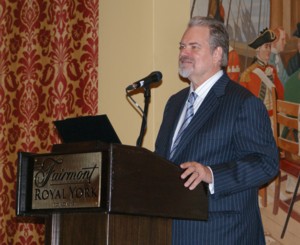

 Last Friday, I had the pleasure of attending a talk by Rob Arnott, the creator of the Research Affiliates Fundamental Indexes (RAFI). The Toronto event was hosted by Claymore Investments, who use the RAFI indexes for their flagship equity ETFs.
Last Friday, I had the pleasure of attending a talk by Rob Arnott, the creator of the Research Affiliates Fundamental Indexes (RAFI). The Toronto event was hosted by Claymore Investments, who use the RAFI indexes for their flagship equity ETFs.
If you’re not familiar with fundamental indexing, here’s a primer. Most traditional indexes are weighted by market capitalization, which means that a company’s influence is determined by its size (as measured by the number of shares outstanding, multiplied by the price per share). If a stock doubles in price, its influence in a cap-weighted index will also double. Similarly, if a company’s stock price declines, so does its weight share in the index.
This methodology makes perfect sense if the goal of an index is to be a barometer of the market. Indeed, the cap-weighted S&P 500 was created in 1957 to measure the performance of the U.S. stock market, and other traditional indexes (including the S&P/TSX Composite in Canada) perform the same role.
However, proponents of fundamental indexing point out that these benchmarks were never designed to be the basis of an investment strategy. And in that respect, they argue, cap-weighted indexes have a major flaw: they give the most weight to overvalued companies and the least to undervalued companies.
The trouble with bubbles
The most glaring example of this problem occurred during the dot-com bubble. As the price of technology companies inflated to absurd levels, so did their influence in cap-weighted indexes. Meanwhile, profitable business that fell out of favour saw their stock prices and their index weight plummet. When the bubble finally burst in March 2000, the S&P 500 was decimated.
The RAFI fundamental indexes remove stock prices from the equation. They assign each company a weight based on four factors: total sales, book value, cash flow and dividends. What’s more, they use an average of these factors over five-year periods to smooth out any short-term aberrations. The result is an index that measures companies based on their footprint in the economy, rather than their footprint in the market.
Nortel is the most obvious Canadian example of how big a difference this can make: in 2000, the company made up more than 29% of the S&P/TSX Composite, but would have been less than 4% of a RAFI index based on its fundamentals.
A fundamentally different method
As the ETF marketplace grows, all manner of new indexes are cropping up in attempt to address the supposed flaws of cap-weighting. Many have more to do with marketing than anything else. But the RAFI indexes are in a different category. While they don’t have universal support in the academic community, they are based on peer-reviewed research and have been endorsed by none other than Harry Markowitz, the Nobel laureate and creator of Modern Portfolio Theory, the rock upon which index investing is built.
They’re also popular with advisors who use Dimensional Funds, which isn’t surprising, as the strategies have some similarities: both are designed to get away from the “growthiness” of cap-weighted indexes and place more emphasis on value stocks.
As Arnott described during his talk, indexes weighted by company fundamentals would have outperformed cap-weighting by an average 2.8% annually in 22 of 23 developed countries since the 1980s. His book, The Fundamental Index, goes in to much more detail and makes a deeply compelling case for the strategy. It’s a must-read for anyone thinking about building a portfolio with the RAFI-based funds from Claymore and PowerShares.
The promise of fundamental indexing is enormous. However, it’s important to remember that the long-term performance of the strategy is hypothetical. The data assume that funds based on the RAFI indexes would have tracked their benchmarks perfectly—and that’s always a big assumption. The first ETFs and mutual funds based on the RAFI indexes have been live for only five or six years, with mixed results. Later this week I’ll look at how some of them have stood up in the real world.
 Last Friday, I had the pleasure of attending a talk by Rob Arnott, the creator of the
Last Friday, I had the pleasure of attending a talk by Rob Arnott, the creator of the 








